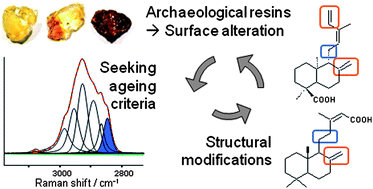Non-destructive characterization of archaeological resins: seeking alteration criteria through vibrational signatures
Abstract
Natural resins are prone, like all natural organic products, to ageing and degradation. Characterizing this alteration provides better knowledge about their chemistry, and when they are involved in cultural heritage artefacts, it helps to define relevant conservation protocols. In this study, a set of archaeological African copals that present specific surface degradations and colors were analyzed by FT-Raman and ATR-IR spectroscopies. A methodology based on the modifications of the vibrational features between the bulk and the resin surface was defined. A relationship between the evolution of the molecular structure of the copal samples and some vibrational bands could be established; and possible ageing reactions occurring at the surface of the samples could be proposed. This specific surface aspect is actually related to an alteration, and the surface states and the color variability are linked to different alteration degrees. This could refer to different conservation contexts (presence of air, water, etc), possible preparation or different origins: for example the collection of fresh or partly fossilized resins.

- This article is part of the themed collection: Molecular Analysis for Art, Archaeometry and Conservation

 Please wait while we load your content...
Please wait while we load your content...